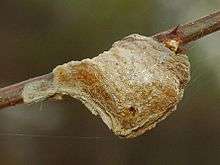Sang piao xiao
Sang piao xiao or Sangpiaoxiao (Chinese: 桑螵蛸,[1][2] sometimes called Mantis Cradle[3][4] or "Ootheca Mantidis"[2][5][6][7] in English) is a Pinyin transliteration referring to the oothecae, or egg case, of the praying mantis as an ingredient in traditional Chinese medicine. A formula based on this ingredient is known as sang piao xiao san (or sangpiaoxiao san) and is also known as "mantis formula" in English.[1] The formula may also be sold as a pill ("sang piao xiao wan").[4][8]
Varieties
The three most common varieties of sang piao xiao are:[1][5][9]
- tuan piao xiao (round mantis egg case[9]) made from the egg case of Tenodera sinensis
- chang piao xiao (long mantis egg case[9]) made from the egg case of Statilia maculata
- hei piao xiao (black mantis egg case[9]) made from the egg case of Hierodula patellifera
History
The use of praying mantis egg case as a medicine is described in the Shennong Bencao Jing, a pharmacological treatise on Chinese herbology from circa 100 AD.[5][10] Their medicinal use might originate from their occasional occurrence on the mulberry plant Morus alba. As its leaves were necessary food for the caterpillars that make silk, much of the plant – including branches, fruits, leaves, and root bark – became revered in ancient China as source of herbal medicine. Says one source, "it would not be surprising that these egg cases, which appeared on some of the plants, were also collected and considered a valuable medicine."[1]
Collection
Othecae are made by mantises in the late summer and they are collected for medicinal use from then until early spring before when they hatch. The egg cases are steamed – killing the developing nymphs inside – and then sun dried or dried in an oven.[1][5]
Medicinal properties
According to the Shennong Bencao Jing described above:
Sangpiaoxiao is salty and balanced. It mainly treats damaged center, mounting conglomeration, and impotence. It boosts the essence, makes pregnancy possible, cures blood blockage and lumbago in women, alleviates the five urinary bleeding disorders...and regulates urination and the water passageways.[10]
Sang piao xiao is largely used for treatment of urinary disorders and impotence today.[5] One writer says it prevents overly-frequent urination by "securing the kidney."[11] Another recommends sangpiaoxiao "To nourish the kidney, promote yang, arrest seminal emission, and reduce urination."[12] One source explains that sang piao xiao is for:
...insufficiency of kidney-yang with deficiency cold of the lower-jiao, spermatorrhea and cloudy urine, impotence and premature ejaculation, it is used with herbs for tonifying the kidney and supporting Yang, consolidating the kidney and preserving essence...[6]
According to another practitioner of traditional medicine:
Although they have not been analyzed to determine their active constituents, a large portion of the egg case is composed of protein, which would explain the frothy material that turns hard (think of egg whites made into meringue). It also contains a variety of unique constituents produced by the metabolism of the insect, such as aromatic compounds that deter ants, birds, and mice.[1]
Royal jelly and silkworm droppings are other insect secretions used in traditional Chinese medicine.[1]
References
- 1 2 3 4 5 6 7 Subhuti Dharmananda, Ph.D., Director, Institute for Traditional Medicine, Portland, Oregon
- 1 2 List of Chinese Herbs
- ↑ Plum Flower - Mantis Cradle Sang PiaoXiaoWan (morningstarhealth.com)
- 1 2 Mantis Cradle Teapills (chineseherbsdirect.com)
- 1 2 3 4 5 Herbal Shop: Mantis egg case (Sangpiaoxiao)
- 1 2 Introduction To Mantis Egg-Case (sang piao xiao)
- ↑ This seems to be fake Latin, perhaps invented by one online purveyor and picked up by other websites
- ↑ Schisandra Fruit Fructus Schisandrae(healthphone.com)
- 1 2 3 4 Famous Doctors in Traditional Chinese Medicine
- 1 2 Yang Shouzhong (translator), The Divine Farmer's Materia Medica, 1997 Blue Poppy Press, Boulder, CO.
- ↑ Mitchell C, et al. (translators), Ten Lectures on the Use of Medicinals from the Personal Experience of Jiao Shude, 2003 Paradigm Publications, Brookline, MA.
- ↑ State Administration of Traditional Chinese Medicine, Advanced Textbook on Traditional Chinese Medicine and Pharmacology, 1995–1996 New World Press, Beijing.
